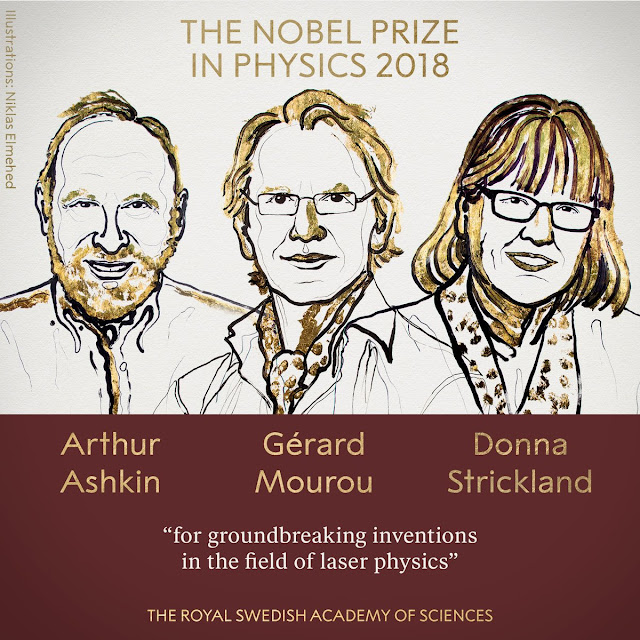As you probably know, the 2018 Nobel prize in physics went to optics and photonics. I cannot say I am surprised, since a lot of the physics Nobel prizes are awarded to this area, either directly or indirectly. It's still nice to see that the people who really deserve recognition are finally getting it. But what is their research really about, and why should we care?
Let's start with Arhur Ashkin, who at the age of 96 years, is the oldest Nobel Laureate ever. Ashkin received one half of the prize “for the optical tweezers and their application to biological systems”. Optical tweezers are exactly what they sound like, a tool used to trap and manipulate minuscule things.
The tweezers were born from the observation that a dielectric particle tends to move towards the highest intensity in a beam of light. So if the particle you are trapping moves to the edge of the beam, a restoring force will move it back towards the center. This force can be explained for Rayleigh scatterers simply by considering the directions of the refracted rays.
When you look at the refracted rays in the above picture, it's clear that when the particle moves towards the edge of the beam, more energy goes to that direction. And like Newton said: every action has an equal and opposite reaction! Because the particle redirects light, it will be rebounded by that action and directed towards the center of the beam. But this is just a two dimensional trap, if we focus the beam we get something like this.
Now the particle is neatly trapped in a three dimensional potential well. Of course, it still moves about, but it kind of hovers around the focal point of the beam, and tightening the focus creates a stronger trap. This kind of tweezers are especially useful in biology, since mechanical ones are waaaay too big and clunky to grab micro organisms with.
However, biology is not the only area where they are really useful, scientists have manipulated even single atoms with them, and very recently
a group forced two atoms to bond by grabbing and smashing them together. When I say it like that, it doesn't sound very delicate, but it is the first step towards supercontrolled chemical reactions and tailored compounds.
Funny thing about these tweezers and the Nobel prize is that in 1997, Steven Chu, Claude Cohen-Tannoudji and William D. Phillips
got the recognition for laser cooling, which is a technology that uses... Optical tweezers. So a special case of the optical tweezers earned the Nobel prize
before the more general technology. Kinda weird if you ask me, but that's how it went.
Now, let's talk a bit about the other half of this years prize, which was awarded to Gerard Mourou and Donna Strickland. They got the prize “for their method of generating high-intensity, ultra-short optical pulses”. Their technique is called chirped pulse amplification, and it is one of the greatest advances in ultra-short pulse generation.
The problem with ultra-short pulses is that they have HUGE peak powers, even if the average power is relatively low. If such pulses interact with matter, they tend to destroy it, but amplification kinda requires interaction with matter. So what to do?
The solution Strickland and Mourou suggested was genius in it's simplicity. They introduced some quadratic spectral phase to the pulses, which stretches them and simultaneously reduces the peak power. Then the pulse can be amplified without destroying the amplifier, and once it's compressed at the output, you get an ultra-short pulse with a very high intensity!
Looking at it now, it seems like an obvious solution. But it was not obvious in the 80's, and people still find the theory surrounding pulsed light confounding at times. Either way, this technology is extremely important and used in just about every high energy ultra-short pulse laser.
Even the laser we have at our university uses it, and it produces pulses that can
literally destroy anything. When passed through a focusing lens, the energy density in the focal point is higher than in the center of the sun! Such powerful lasers are needed in studying light-matter interaction, nonlinear effects and fusion ignition, and they hold great promise for future research.
So there you have it, the technology that awarded the 2018 Nobel prize in physics. It's funny how some media sexy topics like string theory, quantum gravity, or dark matter and whatnot are hyped all the time, but the highest recognition in science always goes to the technologies that have direct consequences to our understanding and everyday life. And quite often those technologies happen to be in the domain of optics and photonics!






Well written (Y)
ReplyDeleteQuite enlightening. Thanks.
ReplyDelete